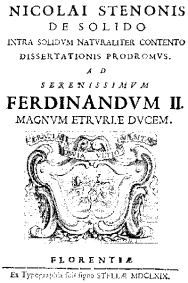 Steno's
Principles of Stratigraphy - Nicolaus Steno (Born Niels Stensen
in Copenhagen in 1 January, 1638, is often considered the the father
of geology. However, since he preceded Darwin by almost two centuries,
neither his genius nor theories were accepted by very many, as belief
in the biological origin of fossils conflicted with religious precepts.
Like Darwin, he undertook intensive empirical observation that resulted
in the 1669 publication of his great work, De Solido Intra Solidium
Naturaliter Contento Dissertationis Prodromus (which preceded a Dissertation
on a Solid Naturally Contained within a Solid), often simply called
the Prodromus. In this work he boldly delineated the organic origin
of fossils and the fundamental principles of stratigraphy. Although
now regarded as a seminal, geological masterpiece, the conclusions
of Prodromus were not were not accepted for another century. Steno's
Principles of Stratigraphy - Nicolaus Steno (Born Niels Stensen
in Copenhagen in 1 January, 1638, is often considered the the father
of geology. However, since he preceded Darwin by almost two centuries,
neither his genius nor theories were accepted by very many, as belief
in the biological origin of fossils conflicted with religious precepts.
Like Darwin, he undertook intensive empirical observation that resulted
in the 1669 publication of his great work, De Solido Intra Solidium
Naturaliter Contento Dissertationis Prodromus (which preceded a Dissertation
on a Solid Naturally Contained within a Solid), often simply called
the Prodromus. In this work he boldly delineated the organic origin
of fossils and the fundamental principles of stratigraphy. Although
now regarded as a seminal, geological masterpiece, the conclusions
of Prodromus were not were not accepted for another century.
Below
are listed the key precepts of Prodomus that are fundamental to contemporary
geology:
The
Principle of superposition
"...at
the time when any given stratum was being formed, all the matter resting
upon it was fluid, and, therefore, at the time when the lower stratum
was being formed, none of the upper strata existed."
That
is, n a sequence of strata, any stratum is younger than the sequence
of strata on which it rests, and is older than the strata that rest
upon it.
Principle
of Initial Horizontality
"Strata
either perpendicular to the horizon or inclined to the horizon were
at one time parallel to the horizon."
Strata
are deposited horizontally and then deformed to various attitudes
later.
Principle
of Strata Continuity
"Material
forming any stratum were continuous over the surface of the Earth
unless some other solid bodies stood in the way."
In other
words, strata can be assumed to have continued laterally far from
where they presently end.
Principle
of Cross-Cutting relationships
"If
a body or discontinuity cuts across a stratum, it must have formed
after that stratum."
Or, more
simply, things that cross-cut layers probably postdate them.
Steno
interpretated fossils as the anatomical parts of living organisms,
particularly teeth, bones, and shells, with fossilization into crystalline
material taking place over extended time.
|